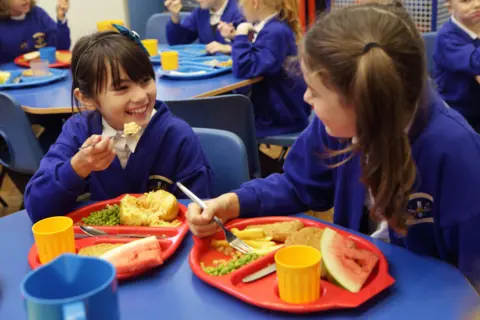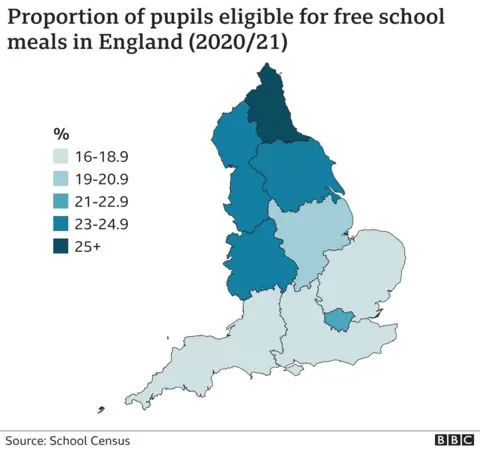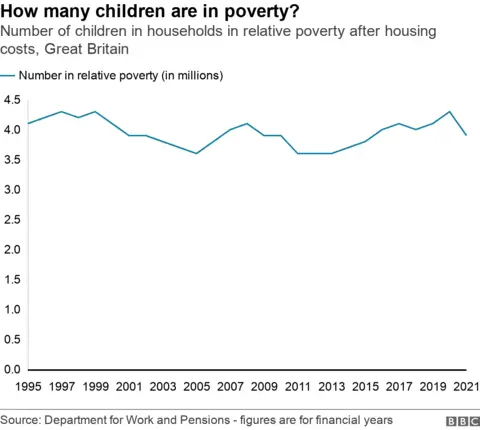Free school meals: How many children can claim them?
 Getty Images
Getty ImagesThe chef Jamie Oliver wants the government to extend free school meals to all children living in households on Universal Credit.
The government said it would keep eligibility criteria under review.
But how many pupils currently qualify?
Who is eligible for free school meals?
In England and Wales, children aged 4 to 16 are eligible for free school meals if they live in a household which gets income-related benefits (such as universal credit) and has an annual income of less than £7,400 after tax, not including welfare payments.
But about 40% of universal credit claimants have jobs. So you can receive the benefit, but earn more than the threshold, meaning your children don't qualify for free school meals.
The income cap is £7,920 in Scotland, and £14,000 in Northern Ireland.
In England, all infant state school pupils (Reception to Y2) can have free school meals during term time - regardless of household income.
Scotland's free school meal programme covers pupils in P1 - P5.
The Welsh government will provide free school meals for all primary school pupils by 2024, beginning with Reception pupils this September
How many children get them?
In June 2022, around 1.9 million children were entitled to free school meals in England - 22.5% of the student population.
That represents a 9% increase from 2021, when 1.74 million pupils were eligible.
In addition to this, another 1.25 million pupils receive free meals under the universal free school meal provision for infant schools.

In Scotland, 80,265 primary and secondary pupils (12%) qualify under the eligibility rules. Another 100,000 primary school pupils get the universal free meals given to younger children.
Under the benefit and household income criteria, 100,000 pupils qualify in Wales (20% of the student population), and in Northern Ireland (30%).
Follow these links to apply for free school meals in:
Where are free school meals most common in England?
The proportion of eligible children varies considerably across the country, but generally matches regional data about deprivation and wealth.
For example, more than a quarter of pupils living in the north-east of England qualify, compared with about 17% of pupils in the south-east.

The highest proportion of eligible students - more than a third - in England is in:
- Islington
- Manchester
- Blackpool
- Camden
- Knowsley
Meanwhile, the lowest proportion - fewer than one in 10 - is in:
- The Isles of Scilly
- Wokingham
- Rutland
- Windsor and Maidenhead
- Buckinghamshire
Some groups are more likely to be eligible than others, including some ethnic minorities.
For example, more than 60% of Irish Traveller pupils are eligible for free school meals.
Roma/Gypsy, Bangladeshi and black pupils also have disproportionately high eligibility.

Are all children in poverty eligible?
According to poverty charity The Joseph Rowntree Foundation, across the UK, an estimated 4.3 million children live in what is called "relative poverty". But only 2.3 million children currently get free school meals.
Relative poverty is calculated by taking the median income - that's the income where half of all households earn more and half earn less - and then looking at how many children live in households earning less than 60% of this.
A household could earn below this threshold, but still not qualify for benefits which would equal free school meals.
In June 2022, the Child Poverty Action group estimated that 800,000 school-age children in England - or one in three of those living in poverty - were missing out.

Is there a measurement for hunger?
Both relative poverty and free school meal eligibility are measurements of income rather than food insecurity - although the two are closely linked.
In the UK, there is no single measure for hunger.
However, in 2019, the House of Commons Environmental Audit Committee considered different assessments in a report on food insecurity. This included research from the UN's Food and Agriculture Organisation which estimated 2.2 million people in the UK were "severely food insecure".
Another indicator of hunger is food bank use.
In the year to March 2022, food banks in the Trussell Trust network distributed more than 2.1 million emergency food parcels to people across the UK.
This was an increase of 14% compared to the previous year. Almost 40% of these parcels went to households with children.
Correction 12 October 2022: An earlier version of this piece implied that the 1.9m children from low-income families receiving free school meals also included the 1.25m children that qualified under the universal free school meal provision for younger pupils. The article has been amended to make clear these figures are separate.



